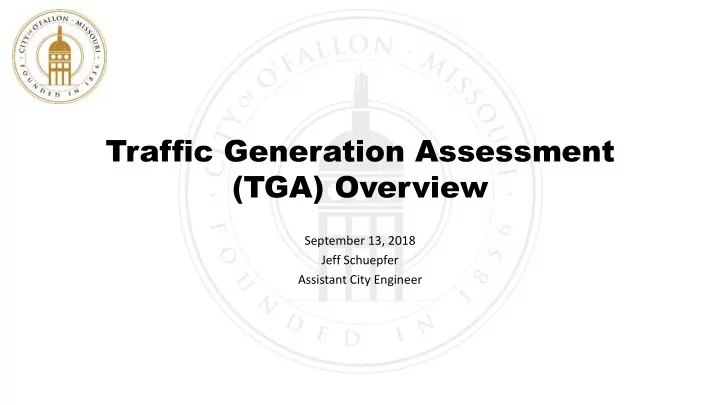

Traffic Generation Assessment (TGA) Overview September 13, 2018 Jeff Schuepfer Assistant City Engineer
Agenda • Roadmap • Problem • Contribution Examples • Status of Funding Options • Development of TGA • Calculation of Fee • Proposed Contribution Examples • Recommendations • Questions 2
Roadmap Council Fall 2018 1 st Reading HBA Review March 2018 P&Z Fall 2018 Council Workshop Council Presentation 1/11/2018 3
Problem • All developments have a traffic impact • Existing ordinance language is good, but doesn’t address specifically how it would be applied. • Leaves things open to interpretation • As a result, costs have not been evenly applied to all developments 4
Problem, cont. • Increased congestion impacts existing system. – More congestion, delays, frustration • Who pays for the road improvements to expand capacity? – Many projects don’t qualify for grant funding (including Federal STP/CMAQ and County Road Board) – City fund availability is decreasing 5
Contribution Examples • Brookview. – Asked for $80,000. Received only $20,000. – Total intersection improvements estimated at $240,000. • Keaton Woods – Asked for $41,800. Received $20,907. – Total turn lane estimate $65,000 • Crystal Ridge Eye Vision office – Received $3,400 – Total intersection improvements estimated around $300,000 6
Status of Funding Options • City staff have sought after several revenue improvements over the last year. – Use tax: Failed in referendum Aug 7, 2018 – Street Light Fee assessment denied by Council December 14, 2017 – Sales tax (full 1.0₵) would have required referendum. Not recommended to proceed forward to voters by Council – Property Tax adjustment recapture was approved. Provides $500k to SRIF • Not a lot of other options to fund the growing transportation 7 assets.
SRIF Funding Problems • Public Works staff presented to Council on May 18, 2017, and discussed roadway priorities and funding needs. • The City’s roadway network is the largest City asset (over 700 lane miles valued at $310 M) and there are not adequate funds within the SRIF budget to maintain the standards desired by Council, staff and residents. • The system continues to grow as more developments occur. Recently, when City development occurs along a County roadway, the County stops maintaining the adjacent road and has been claiming it is now the City’s responsibility. Also, annexing subdivisions adds to the roadway and storm sewer network. • There are also concerns that as online sales , sales tax revenue will
SRIF Funding Problems • Staff estimates that $20 M would be needed in order to meet the strategic goal , “Maintain roadways in a condition such that no more than 10% are below 75 PCI”. • For a 5 year plan approach, it is estimated that $5 M will be needed per year for the next 5 years (2018 – 2022). • Note: Annual Funding will need to increase to $6M and more in the future as the City’s roadway system expands and ages. Construction costs will also increase over time. • Staff will continue to evaluate and update the City Council annually on the progress of meeting the stated strategic goal.
Funding Options Below are funding options that the City Council requested additional information based on the May 18, 2017 Workshop: Combination of three revenue source: • Property Tax – Adjustment can be made by the City Council for 2018 ($500,000) • Street Light Fee – Fee can be established for 2018 ($1M) • Use Sales Tax – County may bring this to voters on August 2018 ballot. – Potential revenue ($2.9M) In total, this increases revenue by an estimated $4.4M. To meet the strategic goal, the additional revenue would come from the existing SRIF revenue.
Funds from TGA • Allows the City to construct transportation improvements that currently are not funded: – Examples: Guthrie and Mexico Traffic Signal Tom Ginnever and Cool Springs Traffic Signal Koch Road/Highway P intersection Improvements Diehr Road improvements • Can be used as City matching funds for larger projects funded by grants. 11
Development of TGA • Council has supported the development of a new policy. • Staff have researched other models – St. Louis County model since the early 1980’s – It has been upheld by court challenges – St. Louis County model based on parking spots 12
Development of TGA, cont. • Proposed City policy based on site generated traffic – Pass-by traffic is removed. – ITE Manual to look up factors. • Determined at time of traffic study, with P&Z. • Other required improvements are credited, so the total amount paid could be reduced. – If required improvements are greater than TGA, City reimburses. • Fee due at construction plan approval. • Funds used towards expansion, not maintenance. 13
Calculation of Fee 14
Calculation of Fee, cont. • Fee estimated at $76.00/ADT generated. 15
Proposed Contribution Examples • With the TGA in place, here are estimated contribution comparisons: Development Estimate of Actual St. Louis County City TGA contribution contribution Brookview Subdivision $55,711 $20,000 $95,619 Crystal Ridge Subdivision $16,448 $3,424 $88,787 Fairways Apartments $71,261 n/a $175,094 QT at Legacy Pointe $371,005 $0 $743,695 Keaton Woods Subdivision $47,752 $20,907 $81,959 Blue Iguana Car Wash $16,448 $3,424 $107,144 Regions Bank $74,278 $20,759 $173,028 16
Recommendations • Tonight is a discussion only. • Is Council ok with the concept of the policy/fee as presented? • Planning and Zoning (public hearing and recommendation) is the next step if acceptable tonight. – Requires a 3-week advertisement for Public Hearing 17
Questions?? 18
Recommend
More recommend